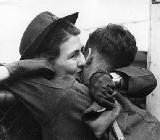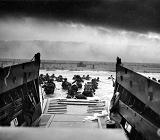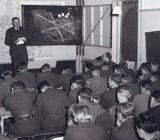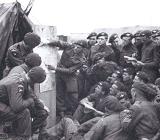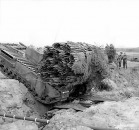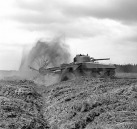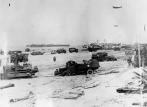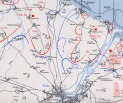The Sword Beach Landings
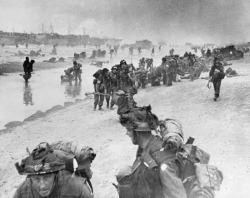
41st RM Commandos landing, June 6th 1944
Tasked with linking up with the British 6th Airborne Division on their left flank, the capture of the town of Caen, ten miles (16km) south of the landing beaches and linking up with the Canadians on their right, the British 3rd Infantry Division had been given the most far reaching objectives of D-Day. General Montgommery had stated that he considered the early capture of Caen as vital for the development of his “Master Plan”. However, the fact that the town was not captured until the 19th of July coupled with his insistence that “everything had worked out exactly as I had planned” has courted controversy ever since. The British troops managed to push south as far as the northern outskirts of Caen but were delayed on their way by stubborn German resistance points, and by the morning of June the 7th, the Germans had formed a strong defensive line, ensuring that the battle for possession of the town and its important road network would be long and costly, drawing in the Canadians as well as the British forces until the town was finally secured on the 19th of July, open the way inland.
The Battle Sites/Sights
The Beach Assault
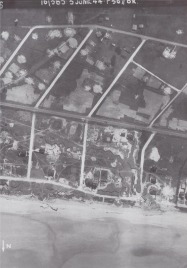
Strongpoint Cod, June 3rd, 1944
The Sword Beach Landings started with the lead assault companies of the 1st South Lancashire Battalion and the 2nd East Yorkshire Battalion landing along about 1000 meters of beachfront between the sea-front villages of Ouistreham and Lion sur Mer. Designated Queen Red and Queen White Sectors, these sectors where the 8th Brigade would be landing were right opposite the German strongpoint WN 20, code named Strongpoint "Cod” on the British Army's invasion maps. It was the primary target of the East Yorkshire assault troops, but they attacked into a withering hail of German fire as the defenders emerged from their deep dugouts to man their guns. The attackers suffered badly from the German fire, especially the tanks, and even when the South Lancashire's joined the effort, it was a slow and painstaking job clearing the enemy strongpoint.
Sights/Sites to See
There is only one bunker remaining of Strongpint "Cod", a position which measured more than three hundred and fifty meters across. The rest of the concrete positions making up this point of German defense have now been built over or demolished. Across the road lies the Meemorial to the lead assault units making up the landings which took place here all those years ago
Sights/Sites to See
There is only one bunker remaining of Strongpint "Cod", a position which measured more than three hundred and fifty meters across. The rest of the concrete positions making up this point of German defense have now been built over or demolished. Across the road lies the Meemorial to the lead assault units making up the landings which took place here all those years ago
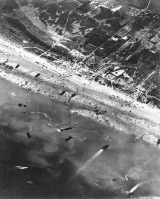
Sword Beach, June 6th, 1944
As the follow up waves came ashore, the 41st Royal Marine Commandos started their push west to link up with the 48th Royal Marine Commandos who had landed at St Aubin sur Mer at the eastern edge of Juno Beach and who were pushing east. This proceeded against scant opposition until they were pushed back after the loss of three tanks by German opposition from strongpoint “Trout”, WN 21. At the same time the Commando's of Lord Lovat's 1st Special Service Brigade pushed inland as quickly as possible, bypassing resistance where necessary, to link up with the Paratroopers at Pegasus Bridge.
Sights/Sites to See
There is a Churchill AVRE Fascine tank on the outskirts of Lion sur Mer in memorial of the soldiers who fought here to link up with their fellow Commandos who had landed at Juno Beach. Three of these tanks were lost while assisting the Commandos attack on strongpoint "Trout"
Sights/Sites to See
There is a Churchill AVRE Fascine tank on the outskirts of Lion sur Mer in memorial of the soldiers who fought here to link up with their fellow Commandos who had landed at Juno Beach. Three of these tanks were lost while assisting the Commandos attack on strongpoint "Trout"
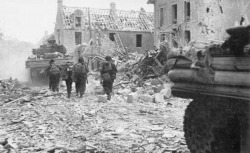
Troops on Sword Beach following a DD tank
Parts of the 1st Special Service Brigade also had addition jobs to perform on D-Day such as the Free French of No. 10 Commando who had the job of attacking the German strongpoint guarding the German Coastal Artillery site at Riva Bella while the artillery position itself was to be attacked by British troops of No. 4 Commando. This required some difficult fighting for the French soldiers, back on their own soil for the first time in 4 years, and it was not until one of the Duplex Drive tanks of the 13th/18th Hussars Armoured Regiment gave assistance that the French could subdue the strongpoint.
Sights/Sites to See
The memorial to the Free French soldiers of Commandant Kieffer's No. 10 Commando who died in the attack on the casino is now situated on top of a steel German cupola. This is an observation cupola of top of one of the bunkers built by the German forces on the ground the casino stood on in 1944. The Germans had destroyed the old casino to build the Bunkered Strongpoint among the ruins.
Sights/Sites to See
The memorial to the Free French soldiers of Commandant Kieffer's No. 10 Commando who died in the attack on the casino is now situated on top of a steel German cupola. This is an observation cupola of top of one of the bunkers built by the German forces on the ground the casino stood on in 1944. The Germans had destroyed the old casino to build the Bunkered Strongpoint among the ruins.
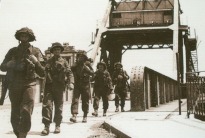
British troops crossing Pegasus bridge
Once this had been accomplished, the soldiers of No.'s 4 and 10 Commando followed on after the rest of the 1st Special Service Brigade. Lord Lovat's Brigade was due to be the first seaborne Allied troops to pass over Pegasus bridge to reinforce and support the British 6th Airborne Division who had landed to the east on the other side of the Orne river and canal. They were to arrive at the bridges five minutes late.
Sights/Sites to See
Please see the section on Pegasus Bridge in the British Airborne Assault page
Sights/Sites to See
Please see the section on Pegasus Bridge in the British Airborne Assault page
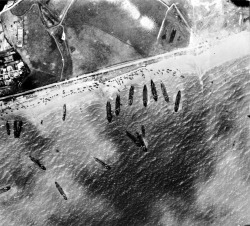
Photo of the landings showing beach traffic jams
All this delayed the British advance off the beach and huge traffic jams resulted. This meant that the Suffolk Regiment had to proceed against it's main opposition, strongpoint “Hillman”, WN 17, without their tank support as it was held up on the beach. This strongpoint was located about four kilometers (two and a half miles) south of the beach and the attack kicked off at midday but the first assaults were beaten off. Controversy ensues to this day that the strongpoint was not bypassed, cut off and isolated as the troops continued on to their main target, Caen, but the Suffolk Regiment spent considerable time planning its next move against “Hillman”. When the tanks did join this later infantry attack, their fire was found to be completely ineffective against the strongly fortified German positions. It was thus left up to the infantry to reduce the German bunkers one by one, blasting the occupants using explosives placed on the doors.
Sights/Sites to See
You will see that the Hillman bunker complex is today found largely as it was in 1944. While the outside of the strongpoint is interesting to look over and open all year, much of the complex is under ground and is open to go inside during the summer months. The entrances to each individual bunker still bear the scars of the explosive charges used to blast them open, one door at a time.
Sights/Sites to See
You will see that the Hillman bunker complex is today found largely as it was in 1944. While the outside of the strongpoint is interesting to look over and open all year, much of the complex is under ground and is open to go inside during the summer months. The entrances to each individual bunker still bear the scars of the explosive charges used to blast them open, one door at a time.
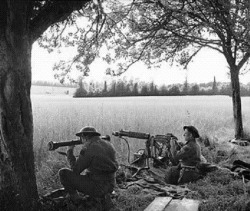
British MG position north of Caen, June 1944
The strongpoint was cleared and able to be bypassed by following troops by late afternoon but the Kings Shropshire Light Infantry ran into the lead elements of the 21st Panzer Division as they advanced northwards in the only German counterattack of D-Day. Although this German counterattack was defeated, it did insure that the drive on Caen on D-Day failed. By the time the advance resumed the following day, the Germans had encircled Caen in an iron grip that it would take the British and Canadians more than five weeks to crack.
